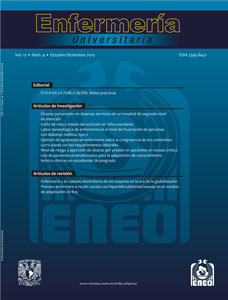Lifestyle and nutritional status among school children
Main Article Content
Abstract
Objective: To explore the association between lifestyle and nutritional status among school children.
Method: Correlational study involving 260 children registered at an ISSSTE clinic, who were randomly selected. A questionnaire on childhood lifestyles was used; weight and height were also assessed. A project approval from the ISSSTE research committee was obtained. Descriptive and inferential statistics were used.
Results: 137 boys and 123 girls with ages between 6 and 12 years old participated. In relation to the nutrition status, five out every ten have a normal weight; two out every ten are over weighted, and one out of every ten is obese or under weighted respectively. In relation to lifestyle, seven out of every ten participants have low risk; and two out of every ten have medium risk. On the other hand a relation between the lifestyle and nutritional status of the children was not found (rs=.038, p > 0.05). Moreover, it was found that children with normal or low weights have better sleep habits in comparison to the children who are over weighted or obese U = 3.79, p < .001).
Conclusions: This study suggests that issues related to the psychological and corporal dimensions, as well as the use of free time, should be further explored because they showed figures which place children within mid and high risks.
Publication Facts
Reviewer profiles N/A
Author statements
- Academic society
- N/A
- Publisher
- Universidad Nacional Autónoma de México
Article Details
Dimensions citation
MÉTRICAS
Enfermería Universitaria by Universidad Nacional Autónoma de México it is distributed under the License Creative Commons Attribution - NonCommercial - NoDerivatives 4.0 International
Accepted and published articles become open-access under the terms of the Creative Commons CC BY-NC-ND 4.0 license, which authorizes the reproduction and sharing without commercial purposes, provided the corresponding acknowledgments to their authors. Authors are allowed to manage a self-archive copy of the article’s published version so that they can open-access it in their personal or institutional web pages, and/or any other broad-diffusion space.


